Scioto Hall, on the right and situated next to Morgens Hall, is set to open to students this fall after a major renovation. Photo/Aaron Hill/Richard Fleischman + Partners Architects, Inc.
Scioto Hall set to open
New housing helps meet demand, as new and returning students
swell campus ranks
by Jessica Noll
513-556-1823
Aug. 1, 2016
As the University of Cincinnati anticipates record-breaking enrollment again this year, housing has gained momentum as well — including the opening of newly renovated Scioto Hall.
UC’s housing department ended the last fiscal year with a challenge: How to attract 12 percent more students to live on campus, to fill the growing number of beds available this year to fit students' needs?
Challenge accepted…. And embraced.
While the housing department originally projected a 300-student growth in admissions, it’s now looking at between 600-700 new freshmen this year. But the number of students seeking campus housing has the makings of university history, says Todd Duncan, assistant vice president for UC’s Housing, Food and Retail Services.
“We’ve always taken the strategy to expand, not restrict,” says Duncan, about adding 600 beds to the housing portfolio this year. “We’re always looking ahead and monitoring growth to get ahead of it.”
In mid-August, more than 6,500 students will converge and make their home in UC housing, both on and off campus — a 25 percent increase since last year, which translates to about 1,300 more students in need of housing than last year.
Stratford Heights tops the list on campus with 813 students taking up residency; followed by Calhoun Hall with 800. Newest on the block, Scioto Hall welcomes 471 students this fall.
Blocked housing, off-campus housing reserved for UC students, is booming as well with more than 700 students moving into nearby apartments like, University Edge, 101 Corry, Steson Square, VP3, USquare, The Verge and Campus Park Apartments.
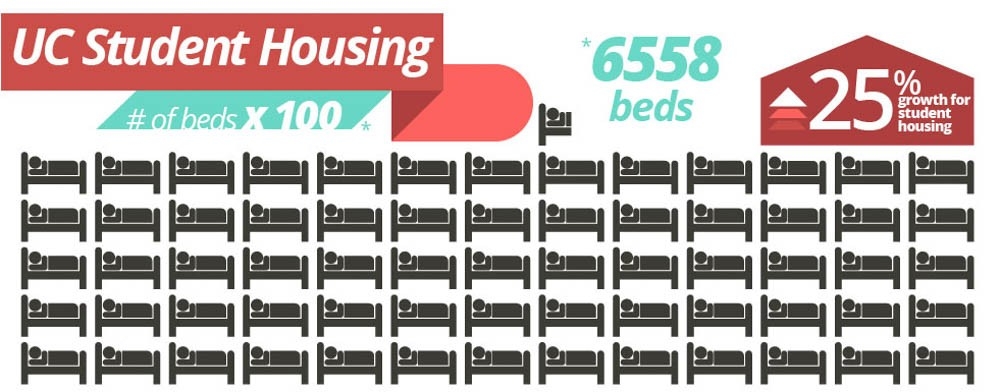
But the challenge didn’t end there.
Growth is a two-prong issue, says Duncan. The first, where to house them? Secondly, where will we feed them all? Luckily, some new digs for fast eats are opening up just in time as well.
Meal plan holders can use their meal swipes at the following all-you-can-to-eat dining locations:
- CenterCourt
- MarketPointe
- StadiumView Café
In addition to these dining experiences, meal plan holders can also use meal swipes at the following “Grab & Go” locations:
- Catskeller (located in TUC)
- DAAP Café
- Bleecker Street Café (located on the UC Blue Ash campus)
New this year:
- Langsam Library Starbucks
- Teachers Café
- CourtsideExpress (Located in Rec Center passageway overlooking the climbing wall.)
Meal swipes will be accepted at CourtsideExpress and the other two locations will be operated like a typical retail location, accepting Bearcat Card, cash or credit.

Scioto Hall’s glass wrap or curtain wall glass provides better insulation than its counterpart in Morgens Hall, saving money and energy. Photo/Lisa Ventre/Creative Services
Grand Opening: Scioto Hall
The housing office started selling housing in January for the upcoming fall semester, which is when they added Scioto Hall and Campus Recreation Center Hall to the mix—the new and improved twin sister to Morgens Hall, says Duncan.
Scioto and Morgens halls initially opened in 1964 and were used for graduate student and family housing, and for more than 25 years Scioto was home to the student health services on the first two floors, says Carl Dieso, director of Housing. However, with $38 million put into Scioto's renovations and $35 million into Morgens three years ago, they’re good as new for incoming students.
Revamped and ready to go, Scioto Hall’s glass wrap or curtain wall glass has better insulation than its counterpart in Morgens Hall, says Duncan, saving money and energy. It also boasts expanded lounges on the ground level, more community space, as well as the choice of a double-single room or double-double room, now holding four students instead of three. This added 24 beds to the dormitory.
“It’s an exciting time,” says Duncan. “We’ve been able to anticipate the changes quickly and respond to meet the demand, while maintaining the student housing experience.”
With a grand opening scheduled for Aug. 11, Scioto Hall joins the other relatively fresh inventory of dorms, including Turner/Schneider halls which opened in 2002, Campus Recreation Center and Stratford Heights in 2005 and Morgens Hall in 2013.
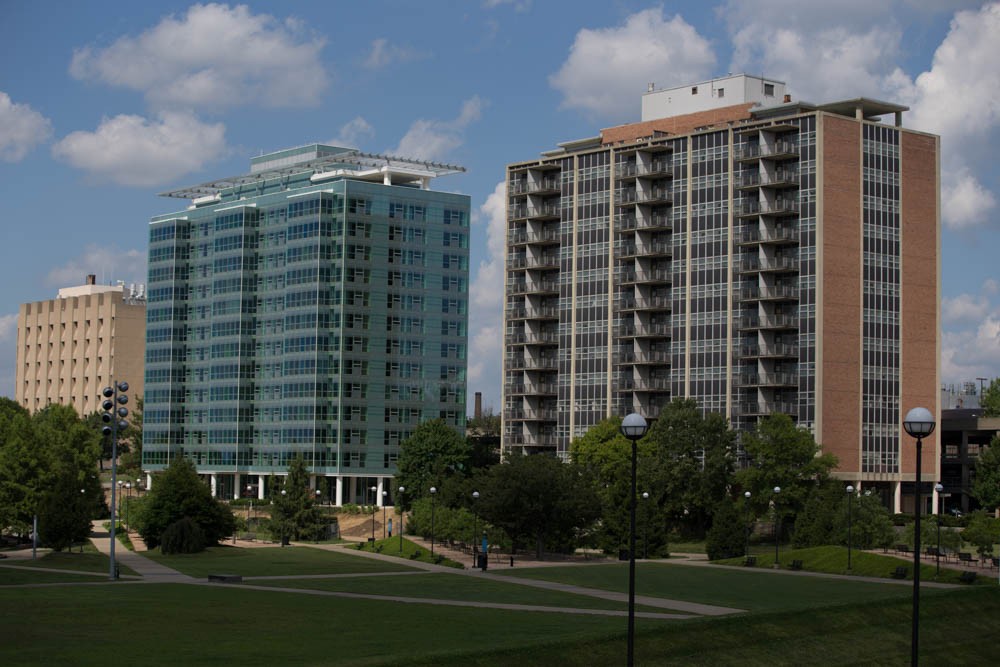
Scioto Hall, on the right, prior to its renovation to match Morgens Hall, to the left. Photo/Lisa Ventre/Creative Services

About $38 million was put into both Scioto and Morgens halls' renovations. Photo/Aaron Hill/Richard Fleischman + Partners Architects, Inc.
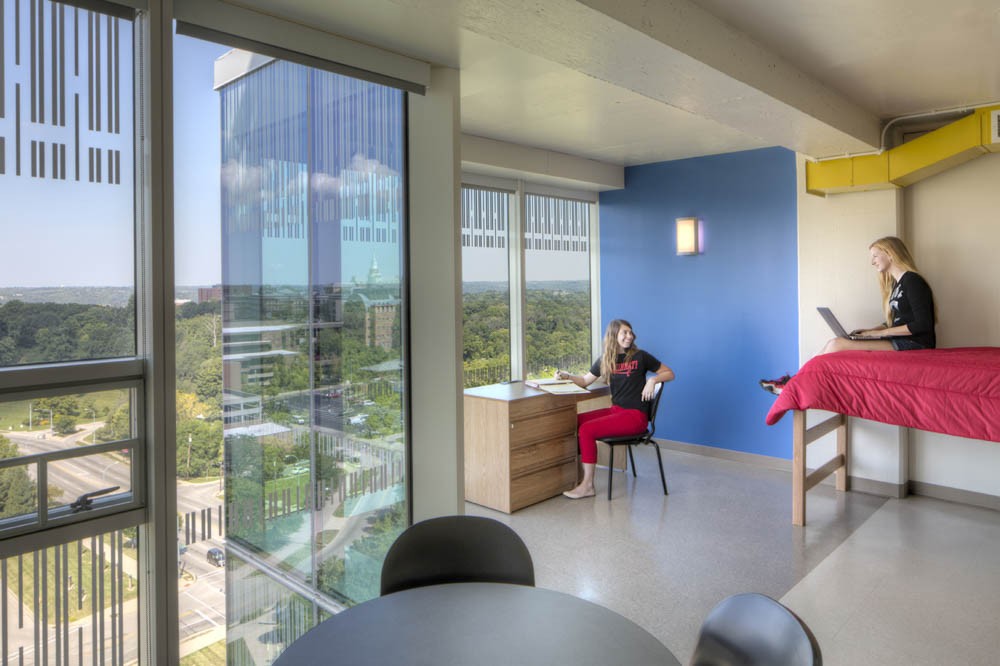
Students chat in their Morgens Hall dorm room, which is very similiar to Scioto Hall's room. Photo/Brad Feinknopf
With record numbers, it’s no surprise there is a waiting list for housing for the fall. As of July, the list topped out at 130 students.
Move-in dates
Wednesday, Aug. 17 (No. of students moving in)
• Calhoun Hall- 800
• Dabney Hall- 419
• Turner/Schneider Halls- 588
• Morgens Hall- 455
• Campus Recreation Center Hall
Thursday, Aug. 18
• Daniels Hall- 780
• Siddall Hall- 543
• Stratford Heights- 813
• University Park Apartments- 750
• Scioto Hall- 471
Want to help students move into their housing? Click here, to contact Helping Hands.
Staying ahead of the game
Perhaps you saw dirt flying around the end of July at the former site of Sawyer Hall — which was torn down in 2005. Slated for a 2017 opening, that space, adjacent to Scioto Hall, will be transformed into a mixed-use high-rise, including:
- 275-seat dining center
- 330 beds of suite-style housing
- Office space for housing/residential development
- Bridge to/from Scioto Hall
Just like Morgens and Scioto, this high-rise will include a curtain wall glass exterior, but will also include brick, tying in surrounding buildings to, what some may call, the “new and improved three sisters.”
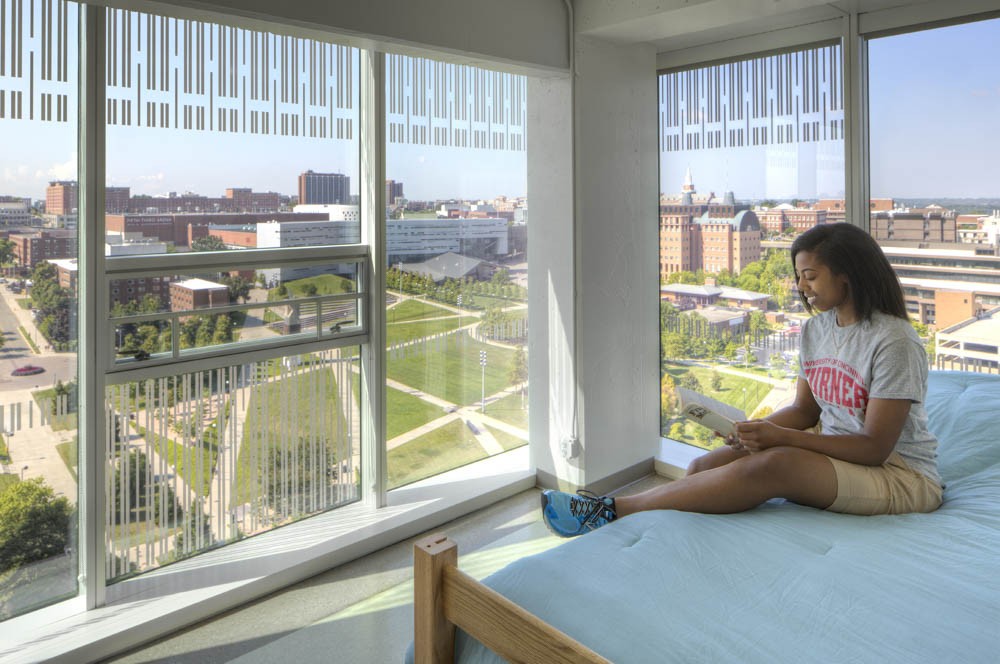
With wall-to-wall windows, students can see nearly all of the campus from Morgens and Scioto hall rooms. Photo/Brad Feinknopf
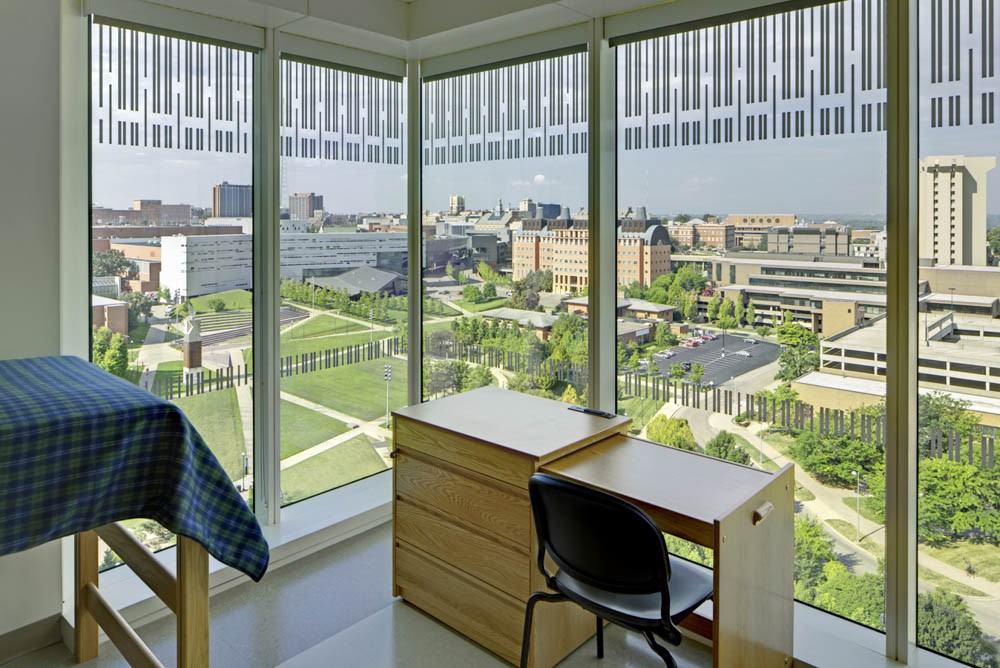
When used in Morgens Hall, the 2-in-1 dresser-desks saved UC more than $90,000 by eliminating the purchase of both separately. Photo/Brad Feinknopf
Schools nationwide reaping benefits of UC's innovation
The clever 2-in-1 dresser-desks, made by Blockhouse Contract Furniture in conjunction with UC designers and first seen at UC’s Morgens Hall three years ago, are now filling dorm rooms in other universities across the country. Its design includes a slide-away desk option that fits under a small dresser, saving space in an already cramped dorm room. As Stratford Heights begins to replace its furniture, it too will be furnished with the 2-in-1s. When used in Morgens Hall, it saved the university more than $90,000 in furniture costs by eliminating the purchase of both a desk and a dresser separately.
The dresser-desk, made from a blend of oak plywood and solid oak, with a scratch-resistant melamine top, is nearly 57 inches wide when fully opened into desk position. It compacts into a tidy 32 inches when closed into its dresser-only position. It includes three drawers, a built-in surge protector, two USB ports and a 9-foot electrical cord.
Blockhouse and UC were the first to offer this patented design to the higher education world, according to Steve Perko, owner and president of Blockhouse.
“The students of today are on the move and like to work or study outside, in their beds and at coffee shops. The use of a traditional desk is not always needed. A student can make a decision of keeping their desk closed for extra space or extended for additional work surface as their work-flow demands.”
In an agreement with Blockhouse, UC receives 4 percent of net sales from the 2-in-1 unit. That money goes into the housing fund — an operational fund where housing revenues and expenses are accounted for — but is not earmarked for anything in particular, says Duncan.
2-in-1 by the numbers
- 2,000 - Approximately the amount of desks that have been sold
- $600 - Cost of each desk
- $48,000 - Approximate desk sales that have gone to UC’s housing fund to date
- 16 - States the desks have been sold in
- 7 - Universities and colleges that use the desks, including UC
- 3 - Years on the market

